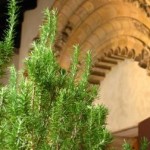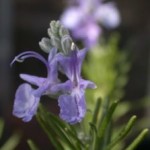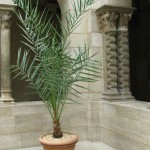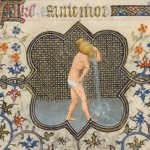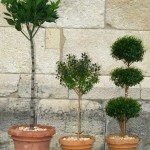
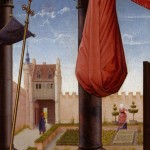
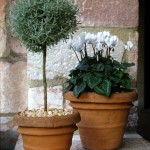
Above, from left to right: Topiaries in the plant collection at The Cloisters; detail from The Annunciation, 1465???75, Workshop of Rogier van der Weyden (possibly Hans Memling, active by 1465, died 1494) (Netherlandish, 1399/1400???1464), The Metropolitan Museum of Art, New York, Gift of J. Pierpont Morgan, 1917 (17.190.7); cotton lavender topiary in Cuxa Cloister.
Medieval topiary was relatively simple and non-representational. Woody plants were trained to standards topped by balls, or to a characteristically medieval form known as an estrade, in which the plant was grown in tiers. Although these are rarely represented before 1400, many fifteenth-century artworks show estrades and other simple, geometric forms growing both in pots and in garden beds. The more ornate representational topiary known to the Romans was revived in Renaissance Italy; the Rucellai garden in Florence, created in the second half of the fifteenth century, included animals and human figures, as well as topiary temples and urns.
The practice of artfully clipping and training woody plants into formal or fanciful shapes can be traced back to imperial Rome and the Natural History of Pliny the Elder, who attributes the relatively recent invention of nemora tonsilia or “barbered groves” to one Gaius Matius, a Roman knight and a friend of the Emperor Augustus (John Boardman, The Oxford History of the Roman World, 2001). Read more »

